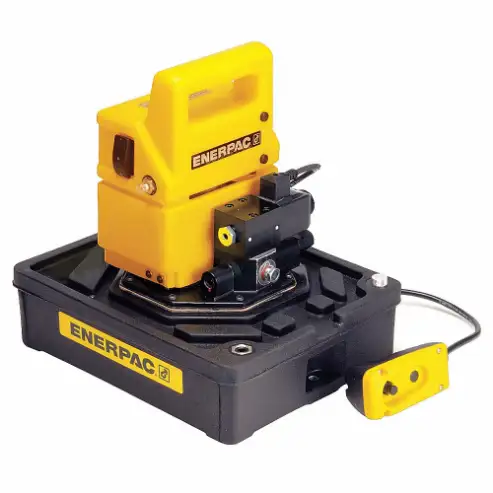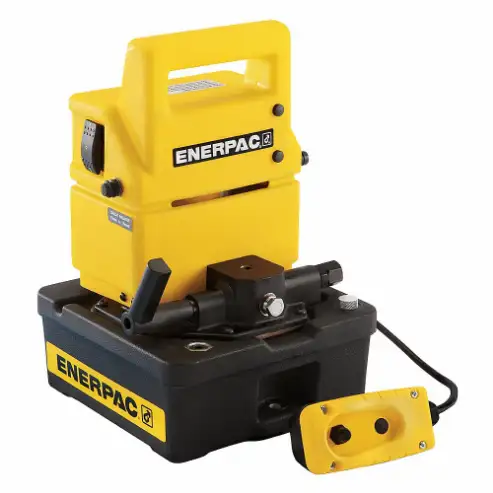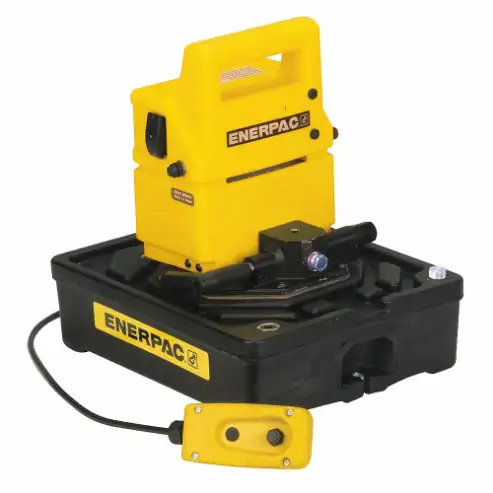Enerpac PUD1100B hydraulic pump provides hydraulic power for lifting, pressing, bending and cutting operations in various industries, such as construction, manufacturing, automotive, oil & gas, mining and more. This pump is ideal for the intermittent operation of small to medium single-acting tools, offering lightweight and high portability.
Working Mechanism:
- A power supply is connected to prepare the hydraulic pump for operation.
- The power switch is then activated to start the pump's motor and generate hydraulic pressure.
- Control settings (pressure, flow rate) are then adjusted according to the requirements which draw pressurised hydraulic fluid from the reservoir within the pump.
- The pressurised hydraulic fluid is then delivered through outlet ports and the hydraulic hoses are connected to desired components or tools.
- Hydraulic power is thereafter supplied to the connected components and the pump operation & hydraulic system performance are monitored.
- The pump is turned off after the hydraulic tasks are completed and then disconnected from the power supply.
Features:
- It comes with a 10 feet cord for improved user safety.
- This hydraulic pump features a high-strength moulded shroud and an integral handle to protect the motor from damage & contamination.
- It has a relief valve range of 2000 to 10000 psi to withstand various pressure ratings during operation.
- This electric hydraulic pump is equipped with a pendant control for precise control from a distance, offering improved flexibility and ease of use.
Frequently Asked Questions:
Q. How do I install this Enerpac PUD1100B hydraulic pump?
A.
- Choose an appropriate location and prepare the mounting surface for installation.
- Position the pump on the prepared surface and securely attach it using suitable fasteners.
- Connect the hydraulic lines to the pump's ports and ensure tight connections.
- Connect the electrical power supply, following safety guidelines and proper grounding.
- Check and adjust the hydraulic fluid level in the pump's reservoir as needed.
- Prime the pump if required, following the manufacturer's instructions.
- Test the pump for proper operation, checking for leaks, unusual noises and other issues.
- Adjust control settings, such as pressure or flow rate, to meet specific requirements.
Q. How do I choose the correct hydraulic pump for my needs?
A.
- Determine the required flow rate and pressure based on your application's hydraulic system requirements.
- Consider the desired pump type (gear, vane, piston) based on performance characteristics and application compatibility.
- Assess the power source availability and match it with the pump's power requirements (electric, hydraulic, air).
- Evaluate the pump's size and weight to ensure it fits within your installation space constraints.
- Consider the pump's efficiency to optimise energy consumption and reduce operating costs.
- Evaluate the pump's durability, including materials, construction, and resistance to environmental factors.
- Assess the pump's noise level and vibrations to meet any noise restrictions or operational comfort requirements.
- Consider the pump's maintenance requirements and availability of spare parts.
- Evaluate the pump's compatibility with other hydraulic system components, such as valves, cylinders and hoses.
- Consider the pump's safety features, such as pressure relief valves and overload protection mechanisms.
- Assess the manufacturer's reputation, warranty and availability of technical support.
- Take into account the cost of the pump and compare it with your budget and long-term operating costs.
- Consider any specific industry standards or regulations that may apply to your application.
- Seek expert advice or consult with hydraulic system specialists for personalised guidance.
- Perform a thorough evaluation and comparison of different pump options before making a final decision.
Q. What safety precautions should I take while operating this hydraulic pump?
A.
- Wear appropriate personal protective equipment (PPE), such as gloves, safety glasses and steel-toe boots to protect against potential hazards.
- Ensure you have received proper training on the operation of the hydraulic pump and follow the manufacturer's instructions & guidelines.
- Inspect the pump and its components for any signs of damage or wear before the operation and report any issues to the appropriate personnel.
- Keep a safe distance from the pump while it is in operation and avoid placing hands or body parts near moving or rotating parts.
- Be cautious of high-pressure hydraulic fluid and potential leaks, ensuring that all connections are secure and the system is properly maintained to prevent accidents or injuries.
 Change Country
Change Country





